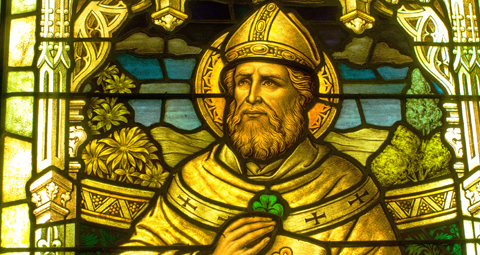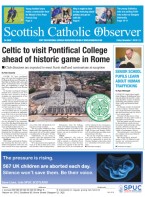August 25 | ![]() 0 COMMENTS
0 COMMENTS ![]() print
print

Finding the saints in our everyday world
AMANDA CONNELLY finds that while St Patrick’ visit to Scotland may only be a myth, its influence is real -BY AMANDA CONNELLY
Traipsing through the undergrowth and towering trees of the Newton Woods, with a careful and knowing eye, you may find yourself stumbling upon a little-known piece of natural history that is all too easily overlooked and forgotten by the non-natives of Elderslie in Renfrewshire.
An ancient spring, known as the Lex Well, is the site of an incredible local legend. Reputed to have been a water source of healing properties, the overgrown well, also known as the Druid’s Stone or Druid’s Altar, was said to have been worshipped by druid priests of iron age Celts, where millennia ago individuals attempted to win the favours of the water goddesses believed to have frequented the well, placing clothing and ornamental trinkets on the trees.
Yet for Christians and those with Irish connections, the legend stretches further, and is said by some to be where St Patrick himself preached the word of God to his flock—the people of Scotland—and again was known as a miraculous place where healing waters flowed. Indeed, the well’s name gives heavy weight towards this story.
“I’d always known about the Lex Well, and I’d sort of heard it was linked to St Patrick,” said journalist Annie McGuire, from Elderslie, who was moved to research the history after a local golf club fenced off the land the well sits on. “There seem to be two or three sources suggesting that this may have been a well that St Patrick preached at.
“Lex in Latin means law, and apparently it specifically means religious law, so the name would suggest that it would’ve been a place where St Patrick would have handed down kind of ecclesiastical law, as part of his mission to bring people to Christianity.”
Disappointingly, despite other hints towards the supposed veracity of the legend such as local place names in Elderslie referencing St Patrick—including Kilpatrick Road and the Alt Patrick Water—doubt has been cast on the legend. Gilbert Markus, an affiliate researcher in Celtic and Gaelic at Glasgow University, has revealed the St Patrick connection to be one that remains the stuff of myth and won’t be finding its way into official historical narratives any time soon.
“There really is no historical evidence of Patrick having preached at Lex Well, or anywhere in that area,” he said, noting that from St Patrick’s own writings, he was the son of a Roman decurion [Roman cavalry officer] and deacon of the early Church in Britain, and lived in a villula [a small country house].
Both were part of civilian Roman Britain in southern England, but there were none in the north or in Scotland, due to the lack of Roman development of estate management there—an area ruled by military administration.
“As the son of a decurion and the occupant of a villula, Patrick must therefore have lived in southern Britain, in the civilian zone of the Roman province,” Mr Markus said. “It will almost certainly have been on the west coast, too, since he was captured by sea-borne Irish raiders as a young man. Somewhere on the Severn might be a good bet.
“The only evidence we have of Patrick preaching anywhere is in Ireland. That is the picture that he himself gives. He gives absolutely no indication in his writing—a substantial autobiography or confessio—that he was ever in Scotland.”
However, for those still willing to hang on to the connection between St Patrick and the Strathclyde region, one real connection remains. A letter penned by St Patrick sees him heavily criticise an apparently British king with Pictish folk among his war-band, who attacked some of the saint’s followers in Ireland, slaughtering many and enslaving others. King Coroticus is believed to have ruled Dumbarton, in an area that would have encompassed the Lex Wood.
“Patrick did not come here, or anywhere else in Scotland, but he knew the king and he knew the violence of this ruler and his warriors from his experience in Ireland,” Mr Markus said. “Perhaps it was as a result of Patrick’s letter to Coroticus that his own name became associated with the lower Clyde area.
“Some centuries after his death, Gaelic-speaking devotees of Patrick decided that he must have been born in that area, and they named a church after him very close to Dumbarton, now called Kilpatrick—Cill Phádraig, ‘church of [saint] Patrick.’”
Kilpatrick’s proximity to the Antonine Wall, known as a Roman construction, may, Mr Markus suggested, have led followers of the Irish patron many centuries later to believe that Patrick came from there, despite the wall having been abandoned two centuries earlier.
“Though there are medieval legends about Patrick’s birth and miracles at Kilpatrick, these are much later devotional legends with no basis at all in the facts as we know them from Patrick’s writings,” he added.
Mr Markus noted that the belief that St Patrick preached in Scotland was ‘popular and influential’ and stories from the late medieval period were given ‘authority and respectability,’ finding their way into official Church liturgical documents, such as the Aberdeen Breviary.
However, there are a number of reasons why these legends may have circulated. Pilgrimages to the birthplace of a saint would generate income and many visitors, and would be of benefit to the local economy in places like Kilpatrick.
“I’m not suggesting that there is anything necessarily dishonest about the creation or repetition of these stories,” he said. “I’m sure that even the people who invented the stories often felt that they were true… developing elements of things that they had heard, trying to make sense of a rock here, a well there, a building over there, imaginatively recreating a landscape of sanctity for their patron saint.”
Despite the reported connection of St Patrick to Elderslie being unfounded, it does, however, raise fascinating questions about how we practise devotion to saints, and the ways in which we connect ourselves to these holy men and women in both the big and the small ways in our everyday lives.
“We all have a Faith in the great overarching cosmic truths of Christ’s birth, death and resurrection, His teaching as found in the Gospels and so on,” Mr Markus said. “But it’s a very big story, and it happened far away. It is compelling, but people always want to see how that big story plays in their own locale, among their own kindred, within their own community’s history. So they look to local saints.
“We want to see how the big Gospel story works out in this place, among our people, with our landmarks.
“The saints’ cults make the Gospel local. Christ is an ikon of the invisible God, but saints are local ikons of the risen and ascended Christ. So we make up stories, go on pilgrimages, weave a story around a local rock.
“We love our saints, and we create stories to weave those human lives around ours.”
Scotland’s Catholic population in the central belt undoubtedly has much of its roots in Irish immigration—ancestors who brought their Faith across the water as they resettled in Scotland, a precious heirloom that has been passed down through Scotland’s generations from a time when materialistic goods and financial affluence were scarce for Scotland’s new arrivals.
Despite the factual accuracy being off, these links to Ireland’s patron saint and Christian heritage can be important reminders for those of an Irish-Catholic background to reconnect with their own familial and religious history. But for all of us, regardless of cultural and national heritage, these myths and legends prompt us to choose to inject the lives of the saints into our own lives in the ordinary ways.
Annie McGuire is campaigning to have the Lex Well saved from the hands of a local golf course, who have erected a fence by the Newton Woods, where the well is located.
It may be factually inaccurate, but giving people access to sites such as this—that may still spark an interest in the saint’s life and help people engage with local culture—is surely important, and it would be a real shame to see this lost for communities.
Despite their legendary status, sites such as the Lex Well help us to stop for a moment, and give us the much-needed reminder that, even in the most unexpected of places, we can find the saints in our everyday world.
It is up to us to draw on that encounter, and use it as an opportunity, a reminder, to emulate their goodness in all places of our










